 |
||
|
||
| ||
TEAC CD-W58E and CD-W512EBToday we have two new TEAC recorders. For the whole time we are dealing with TEAC products we were never disappointed. I can't say that the CD-W512E and CD-W58E models are new for the market. Nevertheless, they are even in a greater demand due to sharp price drop for CD-RW drives. Besides, you are all the time asking us about one or another TEAC drive, thus proving a great interest to the companies' products. So, first up the features of the CD-RW drives under investigation. TEAC CD-W512EBTEAC CD-W58ETest resultsCDWinBench 99 CD-ROM Transfer RateFor comparison of performance in read operations we chose, as always, the CD-ROM TEAC 540E.  The internal data rate of the CD-ROM TEAC turned to be the best. The CD-RW drives showed nearly the same performance level. 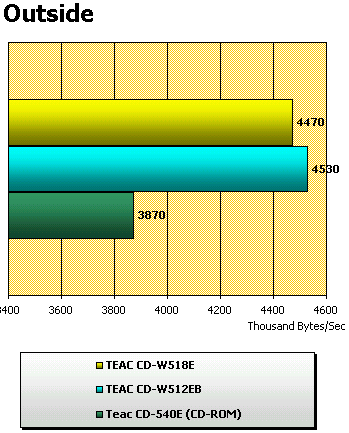 The CD-RW seem to be seriously set about to replace a standard CD-ROM drive. At least, in terms of read speed they are only a bit behind, and in this test they even win over the 40x CD-540E. The CPU utilization was: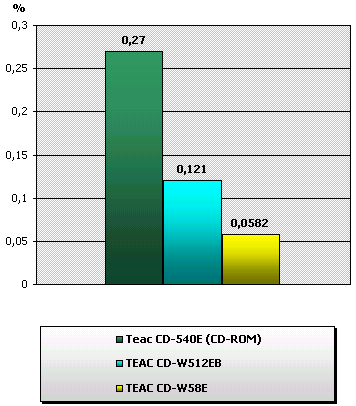 Like in the majority of the previous reviews, the TEAC 540E shows the greatest CPU load. Judging by the diagram, the W58E loads the CPU less than the W512EB. But in fact, the difference is nearly absent, since it's very difficult to feel difference between 0.1% and 0.05% CPU utilization. CDWinBench 99 CD-ROM Access Time
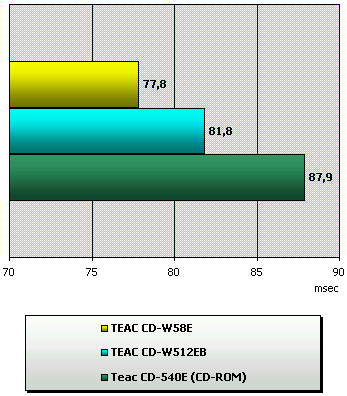 All models show even better results than expected. The TEAC CD-W58E is a leader. CDWinBench 99 CPU Utilization
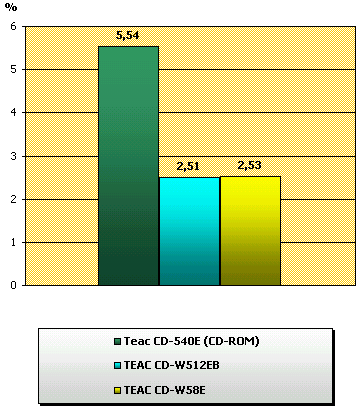 Despite high total results the TEAC recorders showed almost two times less CPU utilization than the CD-ROM TEAC. It means that the new generation of drives has a better realized data transfer protocol than of the CD-ROM and CD-RW models. Time taken for CD recordingToday many users when buying a CD-RW drive are choosing between the TEAC CD-W54E and CD-W58E, pondering whether 8x record and re-record speed is important for them. That's why we have taken the results of the very first CD-RW drive from TEAC. So, we had to make an additional testing on the 4x model in order to define a record speed of the phthalocyanine CD-R Mirex. The 12 x recorder have already been compared with the analog models from TEAC and Plextor. Check the test results in the first part on SCSI CD-RW drives' testing. Record of the CD-R Philips Silver Premium (12x)
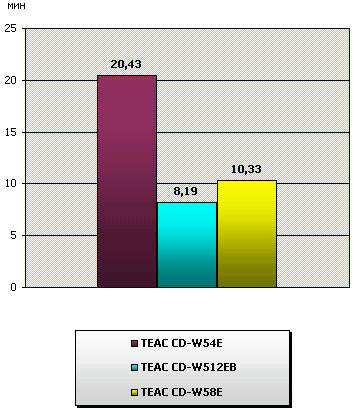 The results are practically proportional to the announced record speeds. It's easy to see that the W58E is twice better than the 4x model. You can save two minutes as compared with the W58E, and more than 20 minutes as compared with the W54E if you work with the rapidest device among the tested ones today and produced by TEAC. Record of the CD-R Noname (4x)
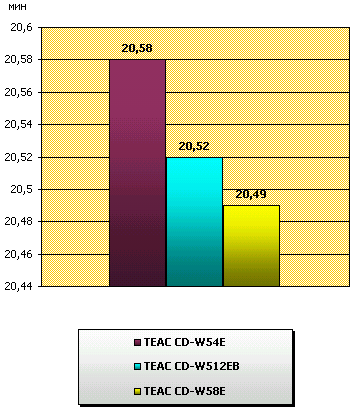 When recording discs at different speeds the W58E took the lead. Nevertheless, 3-4 seconds can be just an acceptable error which can include, for example, such factors as delay in pressing the stop-watch's button or delay in appearing of the message on completion the record. So, I may say that the records spend nearly equal time for 4x record. Time taken for the full formatting of CD-RW disc in UDF format
Philips CD-RW (4x)
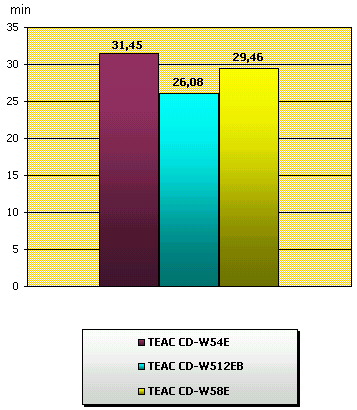 On the test results the drives are placed according to their technological improvement and price level. It means that the slow TEAC CD-W54E has taken the last place, and the modern CD-W512EB is too far ahead, making three minutes margin with the nearest competitor (W58E). Ricoh CD-RW (10x)
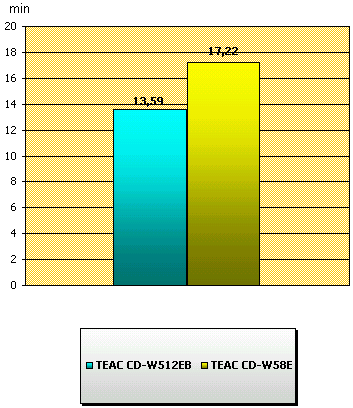 The W512E and W58E performed quite well, acting in accordance with the announced max re-record speeds. Record of CD-RW disc (UDF)
Philips CD-RW (4x)
 The drives have taken the places again in ascending order of the speed characteristics. CD-RW Ricoh (10x)
 Again, you can see high speeds record results on a CD-RW disc by the both CD-RW drives. BLER mark for the recorded CD-R Philips Silver Premium
BLER mark of the recorded CD-R Mirex Gold
BLER mark of the recorded CD-R "Noname"
CDTest 99
Graphs of reading of the recorded CD-R Philips Silver Premium
Graph of reading of the recorded CD-R Mirex Gold
Graphs of reading of the recorded CD-R "Noname"
On the whole, the graphs are even, but I should note that on both the W58E and W512EB there are some drops in read speed on definite parts. It's more clear on the graph of the 12x recorder. The graphs of the discs read by the CD-RW drive CD-W512EB with DMA mode disabled are also of great interest. Graph of reading of the recorded CD-R Mirex Gold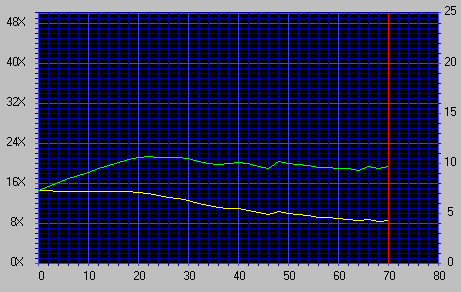 Graphs of reading of the recorded CD-R Philips Silver Premium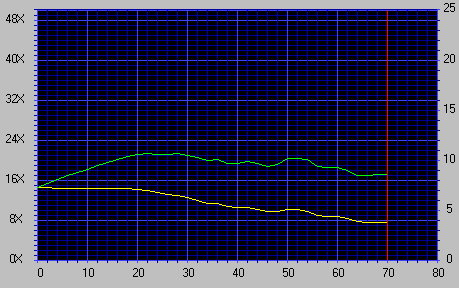 To put it mildly - the graphs are uneven. And the CD-W58E shows rather stable and even graphs in the DMA mode switched off. The initial speed is rather low, that's why we can see a straight ascending line instead of a usual horizontal one - the drive reaches the max speed for the CAV disc rotating mode only to its end. Graph of reading of the recorded CD-R Mirex Gold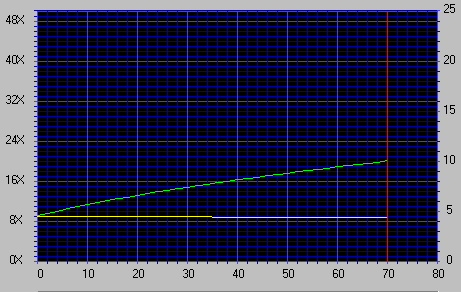 Graph of reading of the recorded CD-R Philips Silver Premium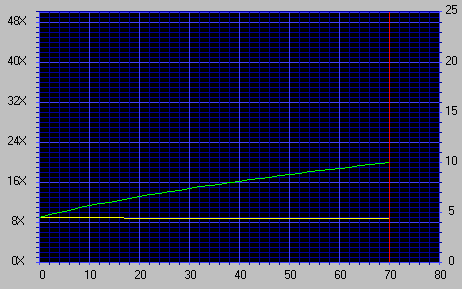 The CD Speed 99 results of the recorded CD-R Philips Silver Premium
The CD Speed 99 results of the recorded CD-R Mirex Gold
The CD Speed 99 results of the recorded CD-R "Noname"
The CD Quality Check results of the CD-RW (UDF) discs recorded at 4x
The CD Quality Check results of the CD-RW (UDF) discs recorded at 10x
The CD Quality Check results of the recorded CD-RW (ISO) discs
The read speed of the W58E drive is not that good. 8-10X is quite low for today, and the results look odd as compared with the modern read results of CD-R and CD-ROM discs. The problem is probably in the firmware version. The read speed of the recorded CD-R Philips Silver Premium (CD Quality Check)
The read speed of the recorded CD-R Mirex Gold (CD Quality Check)
The read speed of the recorded CD-R "Noname" (CD Quality Check)
And, again, the TEAC CD-W58E is leading in read speed, showing even the higher performance as compared with the 40x model of the CD-ROM TEAC. Quality of the recorded CD-R Philips Silver Premium (CD-ROM Drive Analyzer)
Quality of the recorded CD-R Mirex Gold (CD-ROM Drive Analyzer)
Quality of the recorded CD-R "Noname" (CD-ROM Drive Analyzer)
Only the TEAC CD-W58E shows excellent graphs. It's the first time we can see such an even, gradually ascending line up to the max possible speed in the end. The 512 model shows nothing invigorative. Interestingly to note that the Philips Silver discs were read by this recorder more evenly but at the less speed than the "noname" disc or the Mirex one. And for the latter the graph looks like a complete saw, while the CD-ROM TEAC CD-540E has read the disc more stable and without noticeable falls. Audio track extraction from audio CDs (CDDAE 99)
Piano Favorites
Acoustic Planet vol.2
Bloodhound Gang "Greatest Hits"
* - 7.37% means that the drive extracted 7.37% of the CD with errors. And the test for speed and correctness of track extraction from a CD was passed by the W512EB more successfully than by its low-speed competitor. And the former has the number of errors corresponding to the acceptable level, especially taking the correlation extraction speed/error number. Besides, I should note that audio track extraction at the speed around 20X and higher will cause errors. The percentage is low, but they still appear. Direct copying from recorded CDs to the hard drive
Copying of the recorded CD-R Philips Silver Premium
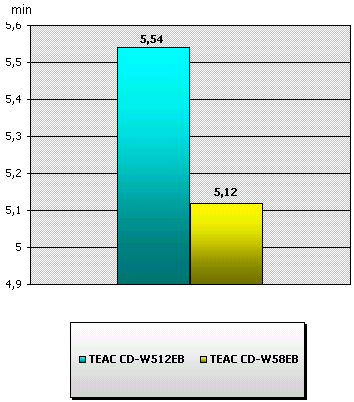 Copying of the recorded CD-R Mirex Gold
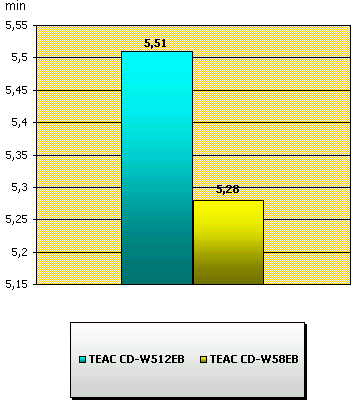 Copying of the recorded CD-R "Noname"
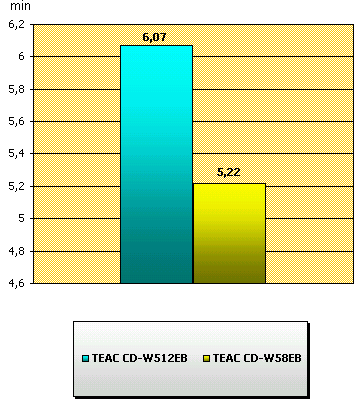 In all cases the TEAC CD-W58E was first to reach a finishing post than its counterpart, outperforming by half a minute. Well, copying of the disc at just a little more than 5 minutes is an excellent result! Reading of damaged CDs
The golden disc reads perfectly - without marked falls and leaps. Reading of the scratched disc was also good: having fallen down from 30X to 10X, after an error part, the disc hurried to lift its speed again, first up to 18X, and at the end of the disc it reached 20X. Very good... The scratched disc was read in 75%.
Comparing with the TEAC CD-W58E results the W512EB graphs look not very attractive. Nevertheless, it's the average results for the most CD-RW drives. The graph for the golden CD is sawtooth approx up to the middle, after that it gets more even though some falls and leaps are still present. Until the damaged part the drive read the scratched disc right like the golden one, having come to the hard-readable part the drive dropped its speed twice, to 2X. Interestingly, that the drive tried to lift the speed up to the initial level but then found that the 8X suits best. The scratched disc was 70% read. Conclusion and summary
TEAC CD-W58EOnly after this model was released TEAC company opened a new market segment of CD-RW drives - a market of inexpensive recorders. Moreover, the CD-W58E drive could be a leader in this niche. Although the production of these recorders was stopped, but they are still shipped from the stocks. How often do you write at 12X? And how strong is the difference between 10x re-write speed and 8x one for you? Considering insignificant advantages, at the first sight, of the W512EB over the W58E, and looking at the lower price of the latter, a user would rather save the money. As for speed and quality of the record the drive keeps the middle. The W58E reads perfectly, and considering high access speed and excellent speed results I can recommend it to replace a standard, the fastest CD-ROM drive. But, unfortunately, speed and quality of track extraction from audio CDs is poor. Of course, at 4X you can get a good WAV-file, but the TEAC CD-W512EB, for example, implements it better. Aside the aforementioned troubles, the W58E reads CD-RW not very good either. If 8-10x read speed on CD-RW discs is acceptable you can consider it an insignificant drawback. TEAC CD-W512EBComparing with the beautiful graphs of the W58E model, this one looks poor. But the first impression is wrong. The recorder is more expensive than its low-speed analog, and offers high speeds which are rare in demand. But there are still some advantage of the W512EB over the W58E. Apart from high speeds, it gives more quality record. Besides, it supports Burn-Proof technology which will be useful in case you are recording and simultaneously working with applications exacting to resources. Besides, I can state that the 12 x CD-RW drive from TEAC is more reliable than its opponent. And above all, pay attention to a quite good audio data extraction speed. I think, that the CD-W512EB drive will become an optimal choice for those who need high quality record even at the max speed. Test programs:
Write a comment below. No registration needed!
|
Platform · Video · Multimedia · Mobile · Other || About us & Privacy policy · Twitter · Facebook Copyright © Byrds Research & Publishing, Ltd., 1997–2011. All rights reserved. |